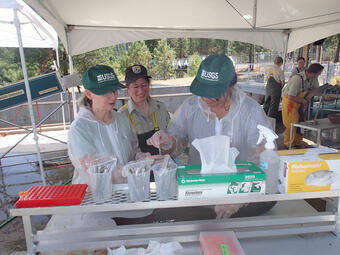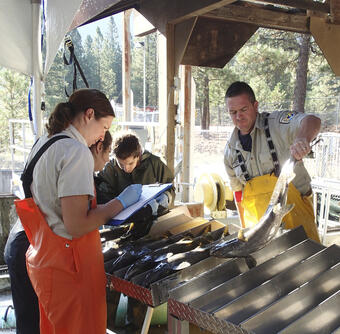For more than five decades the WFRC has worked with partners to provide research findings to managers of aquatic resources. Those partners form a network of clients, colleagues, co-investigators, and customers. Our partners include numerous clients in other DOI agencies such as the FWS, the BOR, and the NPS. But there is much more--we have partners in other federal agencies, state agencies, and universities. WFRC partnerships also include tribal governments, and non-government organizations such as the Nature Conservancy and the Lower Columbia River Estuary Program.

Contributing to Partnerships
The WFRC brings to its many partnerships expertise, research capabilities, and an unbiased approach to conducting and reporting results. Of course, some of our partners are our customers and provide funding that enables WFRC scientists to conduct studies. However, most resource managers also bring insight and relevance to problems with endangered or invasive species not always apparent to scientists. And of course, partners bring natural resource problems, management expertise and relevance, and questions that challenge the research scientists.
How Partners Benefit the Resource
Our partners use the results of science to benefit the resource. For example, the WFRC has a long history of developing new diagnostic tests for fish diseases. Our partners in the FWS use these tests to diagnose fish diseases at National Fish Hatcheries to minimize disease in hatchery-raised fish released to the wild. Our partners at the BOR in the Klamath Basin of Oregon use the results of studies by WFRC scientists to understand the impacts of water management and poor environmental conditions on two endangered sucker species in Upper Klamath Lake and its tributaries.

Nature of Partnerships
The nature of partnerships varies widely. In some cases they are formalized through mechanisms such as contracts, cooperative agreements, interagency agreements, or memoranda, but they also can be informal. In-kind contributions toward research, collaboration on publications and workshops, and service on graduate student committees are some of the ways that informal partnerships are formed. The Center has important partnerships with universities, fisheries partnerships, and community groups that provide significant contributions to our research programs.
International Activities
WFRC scientists collaborate routinely with foreign colleagues on a variety of research and technical assistance efforts. The work can be summarized in several broad science areas:
- Serve as technical experts on international panels dealing with infectious diseases of fishes and aquatic ecology
- Serve as committee members or external thesis examiners for international students
- Develop reagents or assays and provide international reference laboratory services for fish diseases
- Provide training for visiting scientists and conduct workshops in foreign countries
- Collaborate with foreign scientists on internal research projects
Tribal Collaborations
Scientists at the WFRC have a strong commitment to respond to requests for research and technical support from Tribal fisheries agencies and the Department of the Interior bureaus. The assistance is typically in the form of laboratory services, expert advice, technology transfer and research on aquatic animal health issues identified by Tribal fish health managers.
Below are other science projects associated with this project.
Puget Sound Fall Chinook Estuarine Utilization
Research on Emerging Viruses of Salmonids - FHP
Reference Laboratory Service - FHP
For more than five decades the WFRC has worked with partners to provide research findings to managers of aquatic resources. Those partners form a network of clients, colleagues, co-investigators, and customers. Our partners include numerous clients in other DOI agencies such as the FWS, the BOR, and the NPS. But there is much more--we have partners in other federal agencies, state agencies, and universities. WFRC partnerships also include tribal governments, and non-government organizations such as the Nature Conservancy and the Lower Columbia River Estuary Program.

Contributing to Partnerships
The WFRC brings to its many partnerships expertise, research capabilities, and an unbiased approach to conducting and reporting results. Of course, some of our partners are our customers and provide funding that enables WFRC scientists to conduct studies. However, most resource managers also bring insight and relevance to problems with endangered or invasive species not always apparent to scientists. And of course, partners bring natural resource problems, management expertise and relevance, and questions that challenge the research scientists.
How Partners Benefit the Resource
Our partners use the results of science to benefit the resource. For example, the WFRC has a long history of developing new diagnostic tests for fish diseases. Our partners in the FWS use these tests to diagnose fish diseases at National Fish Hatcheries to minimize disease in hatchery-raised fish released to the wild. Our partners at the BOR in the Klamath Basin of Oregon use the results of studies by WFRC scientists to understand the impacts of water management and poor environmental conditions on two endangered sucker species in Upper Klamath Lake and its tributaries.

Nature of Partnerships
The nature of partnerships varies widely. In some cases they are formalized through mechanisms such as contracts, cooperative agreements, interagency agreements, or memoranda, but they also can be informal. In-kind contributions toward research, collaboration on publications and workshops, and service on graduate student committees are some of the ways that informal partnerships are formed. The Center has important partnerships with universities, fisheries partnerships, and community groups that provide significant contributions to our research programs.
International Activities
WFRC scientists collaborate routinely with foreign colleagues on a variety of research and technical assistance efforts. The work can be summarized in several broad science areas:
- Serve as technical experts on international panels dealing with infectious diseases of fishes and aquatic ecology
- Serve as committee members or external thesis examiners for international students
- Develop reagents or assays and provide international reference laboratory services for fish diseases
- Provide training for visiting scientists and conduct workshops in foreign countries
- Collaborate with foreign scientists on internal research projects
Tribal Collaborations
Scientists at the WFRC have a strong commitment to respond to requests for research and technical support from Tribal fisheries agencies and the Department of the Interior bureaus. The assistance is typically in the form of laboratory services, expert advice, technology transfer and research on aquatic animal health issues identified by Tribal fish health managers.
Below are other science projects associated with this project.




